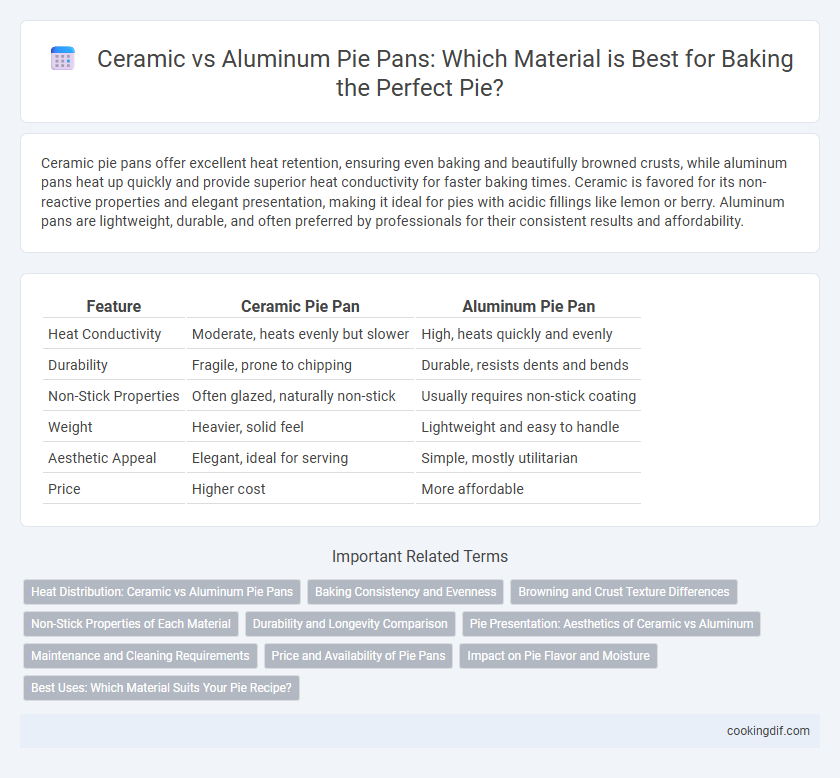Ceramic pie pans offer excellent heat retention, ensuring even baking and beautifully browned crusts, while aluminum pans heat up quickly and provide superior heat conductivity for faster baking times. Ceramic is favored for its non-reactive properties and elegant presentation, making it ideal for pies with acidic fillings like lemon or berry. Aluminum pans are lightweight, durable, and often preferred by professionals for their consistent results and affordability.
Table of Comparison
| Feature | Ceramic Pie Pan | Aluminum Pie Pan |
|---|---|---|
| Heat Conductivity | Moderate, heats evenly but slower | High, heats quickly and evenly |
| Durability | Fragile, prone to chipping | Durable, resists dents and bends |
| Non-Stick Properties | Often glazed, naturally non-stick | Usually requires non-stick coating |
| Weight | Heavier, solid feel | Lightweight and easy to handle |
| Aesthetic Appeal | Elegant, ideal for serving | Simple, mostly utilitarian |
| Price | Higher cost | More affordable |
Heat Distribution: Ceramic vs Aluminum Pie Pans
Ceramic pie pans offer even heat distribution that ensures the crust bakes uniformly, reducing the risk of hot spots and burnt edges. Aluminum pie pans heat up quickly and efficiently, providing excellent heat conductivity that results in a crispier crust. While ceramic retains heat longer for steady baking, aluminum's rapid heat transfer is ideal for achieving flaky, golden-brown pie crusts.
Baking Consistency and Evenness
Ceramic pie pans offer superior baking consistency due to their even heat retention, which helps maintain stable temperatures and prevents hotspots during baking. Aluminum pans heat up quickly and provide excellent heat conduction, promoting even browning but may cause faster crust browning or burning if not carefully monitored. For consistent, evenly baked pies with a well-caramelized crust, ceramic pans are preferred, while aluminum is ideal for quick and responsive temperature control.
Browning and Crust Texture Differences
Ceramic pie pans retain heat evenly, promoting uniform browning and a tender, flaky crust by maintaining consistent temperature throughout baking. Aluminum pans conduct heat rapidly, resulting in faster browning and a crisper, sometimes thinner crust due to quick heat transfer. The material choice significantly impacts crust texture, with ceramic favoring a softer finish and aluminum delivering a more pronounced crunch.
Non-Stick Properties of Each Material
Ceramic pie pans offer excellent non-stick properties due to their smooth, glazed surface that prevents pie crusts from adhering and allows for easy release without excessive greasing. Aluminum pans typically require a non-stick coating or thorough greasing to prevent sticking, as raw aluminum is more prone to causing crusts to stick during baking. The inherent non-stick advantage of ceramic makes it a preferred choice for evenly baked, clean-slice pies without the risk of crust damage.
Durability and Longevity Comparison
Ceramic pie pans offer exceptional durability with resistance to scratches, chips, and high oven temperatures, ensuring long-lasting performance. Aluminum pans provide excellent heat conductivity but are prone to warping and discoloration over time, reducing their lifespan. For longevity, ceramic pans maintain their structural integrity and appearance much longer than aluminum counterparts, making them a superior investment for frequent bakers.
Pie Presentation: Aesthetics of Ceramic vs Aluminum
Ceramic pie pans offer a classic, rustic appearance with their glossy, often colorful finishes, enhancing the visual appeal of homemade pies on the table. Aluminum pans provide a sleek, shiny surface that emphasizes a modern, minimalist presentation but may lack the warmth and charm of ceramic. The choice between ceramic and aluminum significantly influences the aesthetic setting and overall impression of the pie presentation.
Maintenance and Cleaning Requirements
Ceramic pie pans require gentle cleaning to prevent chipping and often need hand washing, while aluminum pans are typically dishwasher safe and easier to maintain due to their durable surface. Ceramic's non-reactive nature means it won't retain odors or stains, but requires careful handling to avoid cracks. Aluminum pans may discolor slightly over time but offer straightforward cleaning with common kitchen detergents and less risk of damage during washing.
Price and Availability of Pie Pans
Ceramic pie pans generally cost more due to their durable and heat-retentive properties, making them a popular choice for even baking. Aluminum pie pans are widely available and budget-friendly, favored for their lightweight design and excellent heat conduction. While ceramic pans can be found in specialty kitchen stores and online, aluminum pans dominate supermarkets and bulk retailers because of their affordability and accessibility.
Impact on Pie Flavor and Moisture
Ceramic pie pans provide even heat distribution, which helps maintain consistent baking temperatures and enhances the pie's flavor by allowing the crust to brown evenly without overcooking. Aluminum pans heat up quickly and promote a crisp crust but can sometimes cause the pie to lose moisture more rapidly, potentially resulting in a drier filling. Choosing ceramic helps retain moisture within the pie, preserving flavor and preventing the crust from becoming overly hard, while aluminum offers a firmer, crunchier texture that may slightly alter the pie's moisture balance.
Best Uses: Which Material Suits Your Pie Recipe?
Ceramic pie pans offer excellent heat retention and even baking, making them ideal for custard or fruit pies that require slow, consistent cooking to avoid sogginess. Aluminum pie pans heat up quickly and promote a crisp, golden crust, perfect for flaky pastry shells or savory pies that benefit from high-temperature baking. Choosing ceramic suits recipes needing gentle heat, while aluminum is preferred for pies demanding a crispier texture and faster bake times.
Ceramic vs Aluminum for pie pan material Infographic

 cookingdif.com
cookingdif.com